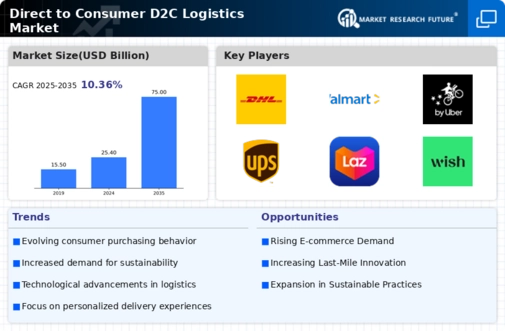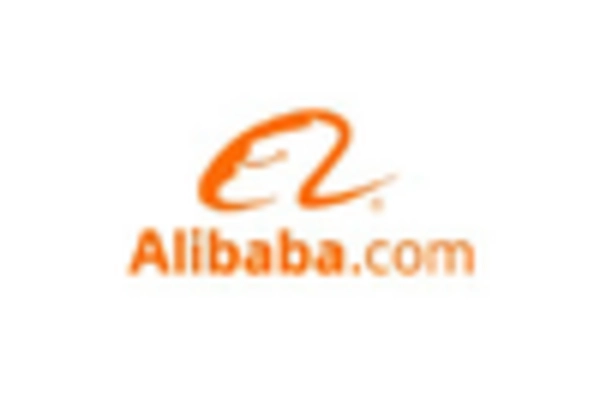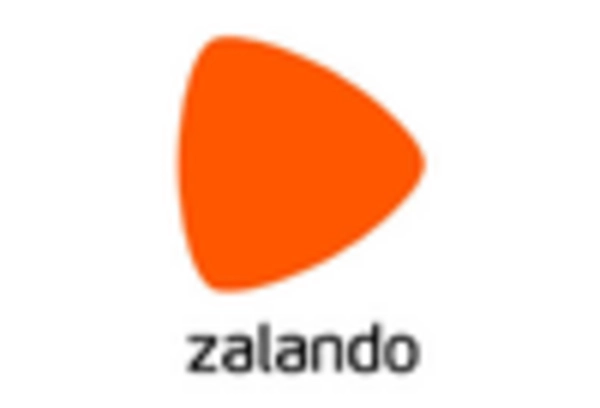E-commerce Growth
The rise of e-commerce has been a pivotal driver for the Direct to Consumer D2C Logistics Market. As consumers increasingly prefer online shopping, the demand for efficient logistics solutions has surged. In 2025, e-commerce sales are projected to reach approximately 6 trillion USD, indicating a robust growth trajectory. This trend necessitates logistics providers to adapt swiftly to the evolving landscape, ensuring timely deliveries and enhanced customer experiences. The D2C model allows brands to establish direct relationships with consumers, thereby streamlining the supply chain and reducing costs. Consequently, logistics companies are compelled to innovate and optimize their operations to meet the heightened expectations of consumers, which further propels the growth of the Direct to Consumer D2C Logistics Market.
Consumer Expectations
Consumer expectations are evolving rapidly, significantly influencing the Direct to Consumer D2C Logistics Market. Today's consumers demand faster delivery times, often expecting same-day or next-day shipping. This shift in expectations compels logistics providers to enhance their operational capabilities to meet these demands. According to recent surveys, nearly 80% of consumers indicate that delivery speed is a critical factor in their purchasing decisions. Additionally, the desire for personalized services and seamless returns processes further complicates logistics operations. Companies that can effectively address these expectations are likely to gain a competitive edge in the market. Therefore, understanding and responding to consumer preferences is essential for success in the Direct to Consumer D2C Logistics Market.
Sustainability Trends
Sustainability trends are increasingly becoming a focal point within the Direct to Consumer D2C Logistics Market. As consumers become more environmentally conscious, they are more likely to support brands that prioritize sustainable practices. This shift is prompting logistics companies to adopt greener solutions, such as electric vehicles and eco-friendly packaging. In 2025, it is anticipated that the demand for sustainable logistics solutions will grow by over 30%, reflecting a significant market shift. Companies that invest in sustainable logistics not only enhance their brand image but also attract a growing segment of eco-conscious consumers. Thus, sustainability is not merely a trend but a critical driver shaping the future of the Direct to Consumer D2C Logistics Market.
Technological Advancements
Technological advancements play a crucial role in shaping the Direct to Consumer D2C Logistics Market. Innovations such as artificial intelligence, machine learning, and automation are transforming logistics operations, enhancing efficiency and accuracy. For instance, AI-driven analytics can optimize inventory management and demand forecasting, leading to reduced operational costs. In 2025, it is estimated that over 70% of logistics companies will adopt some form of automation, which could significantly improve delivery times and customer satisfaction. Moreover, the integration of advanced tracking systems allows consumers to monitor their orders in real-time, fostering transparency and trust. As technology continues to evolve, logistics providers must adapt to remain competitive in the Direct to Consumer D2C Logistics Market.
Global Supply Chain Resilience
The need for global supply chain resilience has emerged as a vital driver for the Direct to Consumer D2C Logistics Market. Recent disruptions have highlighted the vulnerabilities within traditional supply chains, prompting companies to rethink their logistics strategies. In 2025, businesses are increasingly focusing on building more resilient supply chains that can withstand unforeseen challenges. This includes diversifying suppliers, investing in local fulfillment centers, and enhancing inventory management practices. By fostering resilience, companies can ensure continuity in their operations and maintain customer satisfaction. As a result, the emphasis on supply chain resilience is likely to shape the logistics landscape, driving innovation and efficiency within the Direct to Consumer D2C Logistics Market.


















Leave a Comment